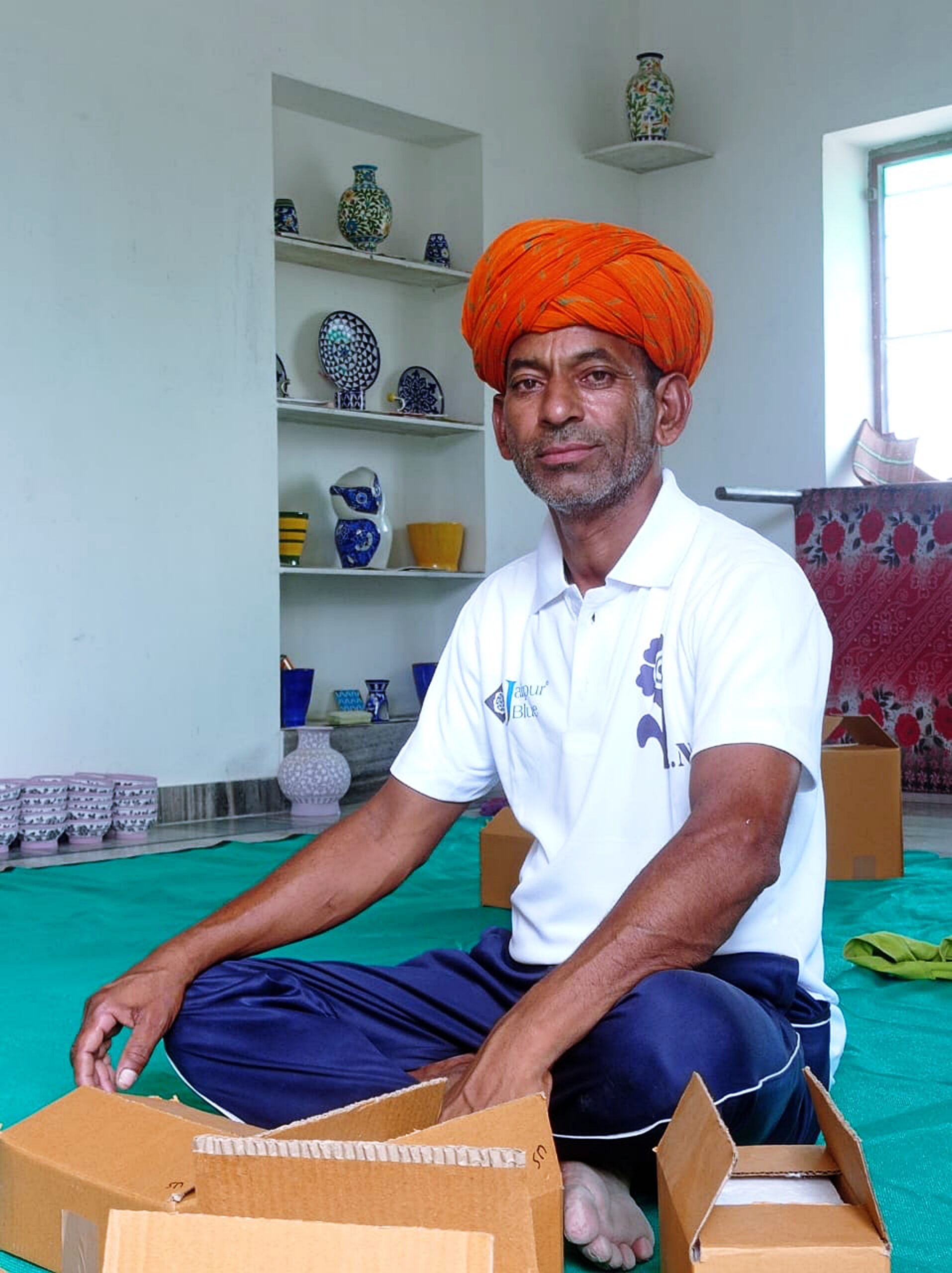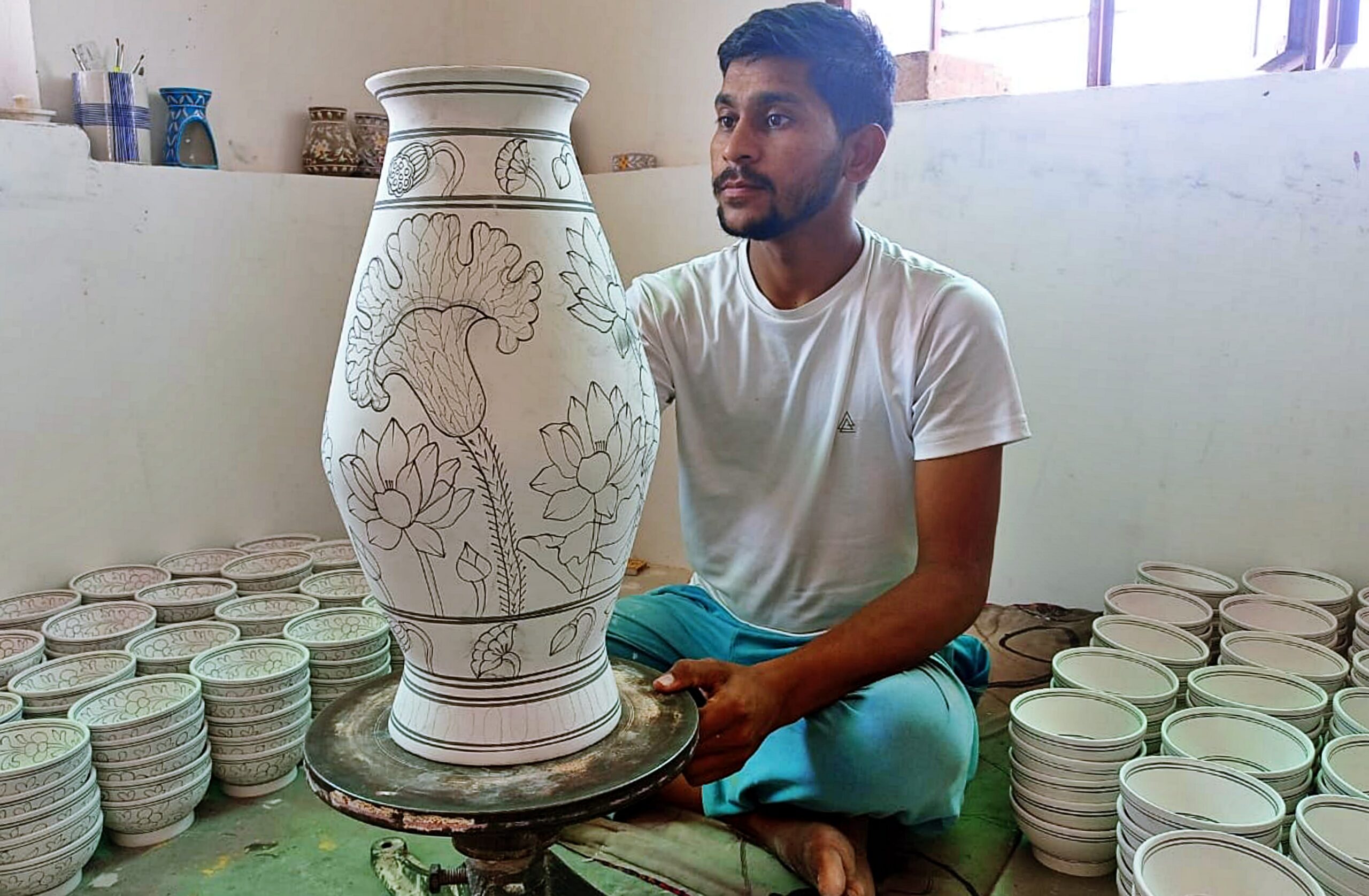Blue Pottery by Ramnarayan Prajapat
The distinctive craftwork of Jaipur is blue pottery, and Kot Jewar is where it is produced. Visitors from all over the world come to this village to admire the exquisite artisan work India has to offer.
Blue pottery is a labour-intensive, 100-year-old Rajasthani craft that employs conventional techniques to create ceramics. The pottery was originally coloured only with a striking blue dye, hence the term Blue Pottery. It is one of numerous blue and white Eurasian pottery varieties and is more distantly related to Islamic pottery and Chinese pottery in terms of shapes and design. Rajasthani Blue Pottery is glazed and burned at a low temperature using a frit substance that is akin to faience, making them very fragile. Vases, ashtrays, plates, bowls, coasters, and boxes for trinkets are just a few examples of the ornamental things available. The only available colours are cobalt oxide-derived blue, copper oxide-derived green, and white, however, occasionally other unusual hues like yellow and brown are also used.
A Rajasthani town called Kot Jewar has made a name for itself on the world map, thanks to its blue art pottery. Kot Jewar draws visitors from all over the world who want to witness the incredible traditional Indian crafts practised and passed down for generations. Ramnarayan Blue Art Potteries, a second-generation business led by master artisan Ramnarayan Prajapat, has grown not just in India but also internationally. The reason why this artwork is special is that this is the only technique that delivers pottery without clay.

After bagging enormous offers, including one for 40,000 pieces of dishes, bowls, and other items from the US and UK and most recently 200 pieces from Taj Mumbai, 24-year-old Vimal Prajapat confers his father’s efforts to resuscitate the dwindling art of Rajasthan blue pottery and the efforts that went into popularising it throughout the world.

“Even though my grandfather was a farmer, we lived in a very poor village, and our family was no exception. My father, who’s an 8th-pass, left the village at the age of 15 to learn the craft of blue pottery in Jaipur and Jodhpur, then returned to our hamlet and altered its course,” Vimal Prajapat, the 2nd-generation owner tell us.
Table of Contents
Taking the Bootstrap Startup Global
Vimal Prajapat told us that his father began working at the age of 15 because the family was in dire straits. His father Ramnarayan Prajapat (65) had to start making pottery at an early age to support the family. Ramnarayan Blue Art Potteries was founded on 20th August 1980 as a bootstrap startup, but in recent years, it has taken part in several training programmes for small and medium-sized enterprises and has managed to generate capital that the family had initially invested in the company. In a government-sponsored contest, Ramnarayan Blue Art Potteries was awarded the best brand in India in 2019.
Vimal Prajapat pleads that the Ministry of Micro, Small & Medium Enterprises allows him to advertise his pottery and draw in more clients, but he contends that the government might give rural workers more opportunities by offering training sessions more frequently. According to Prajapat, before the pandemic, he collaborated with 300-400 rural artisans, including 50–70 women, to produce these ceramics. Today, just 100 of those artisans work for him full-time, and many more have opted to become independent contractors.
When there are substantial orders, they cooperate with independent contractors, provide the necessary raw materials, and complete the work. While many foreign visitors come to Ramnarayan Blue Art Potteries to appreciate the traditional art; students particularly visit to learn the craft.
Why is Blue Pottery so uncommon?
The Blue Pottery is the only artwork that engages a technique where the pottery is made without clay. The reason for the moniker “Blue Art Pottery” is because, in the beginning, only blue products were offered. But after much experimentation, the goods are now also offered in yellow, green, and light blue in addition to the original blue colour. Instead, the artisans make use of gum, water, Fuller’s Earth (Multani Mitti), and quartz powder.
The artists of Ramnarayan Blue Art Potteries assemble a broad variety of blue pottery items, including flower vases, trays, bathroom accessories, soap boxes, hanging plates, bowls, planters, and much more. When we questioned Vimal about how Ramnarayan Blue Art Potteries was able to expand abroad, he said that the internet was very helpful.
Currently, the company exports its wares to New York, Canada, California, and the Netherlands. They have a website where customers from all around the world can place orders, and Prajapat guarantees delivery of the requested goods in return. Vimal and his brother Nand Kishore (28) manage the exports as his father isn’t interested in marketing. Additionally, they get orders from Amazon and their social media pages.
Setting a milestone
According to Vimal, making Blue Pottery articles is very formidable and time-consuming since it requires hand labour and is so delicate that damage is inescapable. It takes close to 15 days to make a blue pottery item. For example, it will take 15 days to make a plate, whether there are one or one hundred. This is because the object must go through various stages.
The damage ratio is 30–40%, and if damage happens before firing, materials can be used to recreate the item; however, if damage happens after firing, craftsmen must start building those goods from scratch. Despite this, the Prajapats complete the orders in time and have accomplished a goal that enabled their family-run business to see unprecedented growth. As Blue art pottery is well-known in India, Vimal wants this unique enterprise to achieve tremendous heights abroad.



